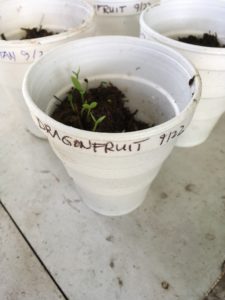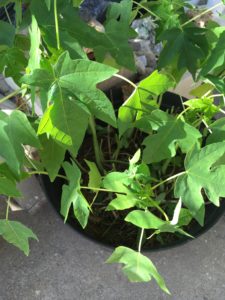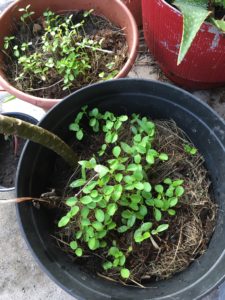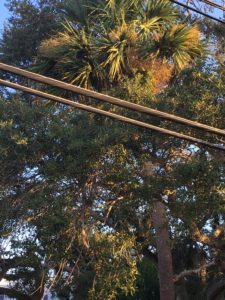
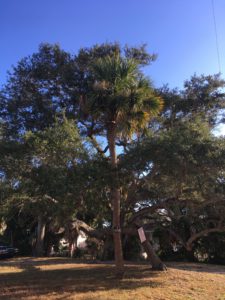
Trees in a forest grow in guilds, rather than in isolation. Oftentimes their branches end up encircling one another or even intertwined. Here in Florida, a common sight is a palm tree growing up into the branches of an oak. This beautiful duo in my neighborhood offer a nice visual metaphor for human interdependency also.
So did the palm tree nurse the baby oak seedling, or was the palm tree seedling nursed by the tall leafy oak? I imagine the latter, as the oak tree looks to be of a stately age, and palm trees don’t offer much shade. But it could have been a different scenario entirely. These trees sit on an empty, mostly grass lot which at one time was probably densely forested with a much wider variety of tree and shrub species.
While googling for an answer (I haven’t found one yet), I stumbled on this article, A Miami Emblem Is Sacrificed for Shade, about how the city of Miami realized it needed to start planting oak trees again. (Truly, there should be no sacrifice required; it should not be an either-or. The palm tree growing within the branches of the oak offers a memorable reminder.)
The article was published back in 2006 but it caught my eye because my city seems to be cutting down a lot of oak trees, as well as palmettos and other native scrub, from public lands, leaving little except wide expanses of buzzcut turf grass and palm trees. A lot of homeowners seem to be doing this as well. It makes for a rather desolate, not to mention hot and relentlessly sun-scoured, landscape.
Further Reading:
Botanical Nursing: From deserts to shorelines, nurse effects are receiving renewed attention: paper in BioScience journal. Fascinating overview of the various aspects of botanical nursing, and how the benefits tend to be mutual rather than one-sided. Key takeaway: “One plant’s reliance on another for its survival and growth has clear implications for conservation: Namely, saving a species dependent on nurse plants requires saving the nurse plants and endangerment of a nurse species endangers plants that depend on it.” Something for cities (and homeowners) to keep in mind as they remove seemingly “extraneous” or “undesirable” vegetation. Also: “Just as nurse plants are important to preservation, they can also be useful in restoration. … [W]ork on denuded ski runs in the Swiss Alps has focused on creating ‘safety islands’ — patches of diverse vegetation that provide numerous sites in which seedlings can safely establish.”

